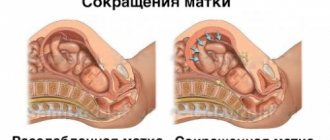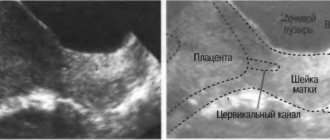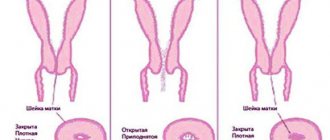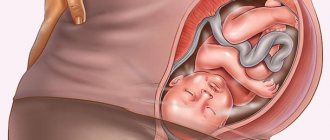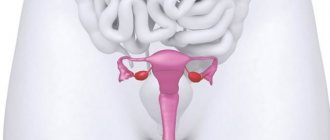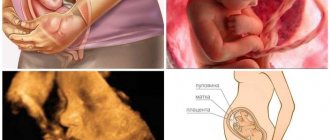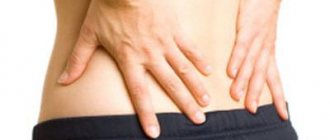The uterus is a smooth muscle organ that undergoes frequent contraction and relaxation . A woman may experience severe tension in this organ during pregnancy and during labor. Otherwise, uterine tension is called tone . Tone is observed in almost every second pregnant woman. But it is worth noting that uterine tension can also occur in women who are not pregnant. Why might uterine tone appear in non-pregnant women?
What is increased uterine tone?
To answer this question, let's first figure out what kind of organ it is. The uterus is a hollow, contractile, muscular organ, the basis of which is the myometrium. Naturally, the uterus enlarges during pregnancy. At the same time, each muscle fiber lengthens 10-12 times and thickens 4-5 times. Nature has arranged it so that normally, for 9 months, the muscles of the uterus are in a calm (relaxed) state. This allows you to carry the child to term. Also, normally, the uterus contracts slightly at times; this happens closer to the expected date of birth. Such contractions - contractions - are called training. This is like a dress rehearsal before the main event - the birth of a baby. But it happens that during a long period of pregnancy (in some cases, throughout the entire gestation period), the muscles of the uterus are in an excited, contracted state. The muscle layer of this organ contracts (its tone increases) - the pressure in the uterine cavity increases. Unfortunately, this is a pathological condition that requires appropriate and timely treatment, since it is a symptom of a threatened miscarriage or premature birth.
When does hypertension occur?
Uterine tone without pregnancy is rare and can be caused by medications or human activities. Several reasons can provoke the appearance of tone during pregnancy. But it is necessary to distinguish between normal tone and increased tone, since only the second type is dangerous.
The uterus has a three-layer structure, the middle level is represented by muscle muscles, which means it is capable of contracting. The fertilized egg attaches to its inner mucous layer. Normally, muscle fibers should not be tense. This type of tone is called normal, or “normotonus”.
Note. The pathological condition occurs when the fibrous layer of the uterus begins to contract intensively, being in a tense state. In this case, we should talk about high uterine tone. What nature of uterine tone during pregnancy - increased or normal - can be determined by ultrasound.
It should be remembered that only hypertonicity of the uterus is dangerous, and with normal tone there is definitely no reason to worry
Causes of increased uterine tone during pregnancy
As a rule, the occurrence of increased tone (hypertonicity) of the uterus is facilitated by nervous stress, fear, overexcitation or overstrain of muscle fibers caused by excessive physical activity.
If tone occurs in the early stages of pregnancy, the cause may be hormonal disorders, in particular, decreased production of progesterone. As a rule, increased uterine tone in the second trimester usually appears due to overload at work or poor lifestyle. In addition, hypertonicity can occur due to inflammatory and structural changes (uterine fibroids, endometriosis). Increased tone can be caused by overstretching of the uterine muscles, which occurs due to multiple pregnancies, polyhydramnios, or a large fetus. Moreover, increased uterine tone can occur as a result of a history of acute respiratory infections or other diseases (flu, sore throat, pyelonephritis), previous abortions, bad habits (smoking, alcohol, etc.). In the third trimester of pregnancy, increased uterine tone can lead to premature birth.
What foods cause uterine tone?
Increased uterine tone during pregnancy is a natural physiological state caused by contractions of smooth muscles.
If the tone is short-lived and does not occur too often, there is no cause for concern. If the expectant mother’s belly hardens, and discomfort or nagging pain often appears, you should consult a doctor. Among the many reasons that cause increased uterine tone, malnutrition stands out. Some foods can provoke tone, so they must be excluded from the diet of a pregnant woman: such food poses an immediate threat to the unborn child.
Uterine contractions may increase if the expectant mother often eats cabbage, legumes, and soy products. Any food that stimulates gas formation helps to increase tone, as the intestines put pressure on the uterus and cause a muscle reaction. Hypertonicity can also occur in black coffee lovers. Strong drink increases blood pressure and increases heart rate.
Frequent consumption of coffee is especially dangerous in the early stages of pregnancy, when the risk of miscarriage due to uterine hypertonicity is quite high. Some doctors do not recommend abusing strong tea, which also contains caffeine. Some types of tea that have tonic properties should be excluded from the diet during pregnancy. Increased uterine tone can be caused by Chinese pu-erh and other highly fermented teas.
During pregnancy, you should refrain from consuming spicy spices and medicinal plants. Even ordinary parsley can provoke tone. It is also dangerous to consume foods rich in essential oils in large quantities. Decoctions of herbs and berries should also be taken with caution.
Anise, cinnamon, viburnum, bay leaf, barberry, basil, cumin, fennel, dogwood, fenugreek, nutmeg - all this can cause contractions of the uterus, accompanied by painful and pulling sensations in the lower abdomen. It is best to avoid consuming such foods and seasonings during pregnancy and not endanger the health of your unborn baby.
How does a woman feel in this state?
- unpleasant squeezing or aching pain in the lower abdomen (can be either barely noticeable or severe); often they are similar to those experienced by a woman before or during menstruation;
- abdominal tension (it becomes hard, as if made of stone);
- often – unpleasant or painful sensations in the sacrum and lower back;
In some cases, pain may be accompanied by bleeding. If this happens, go to the doctor immediately. Also, urgent medical attention is required when a woman experiences cramping pain at intervals of several minutes.
Which doctor should I contact?
In 97% of cases, an immediate visit to a specialist is required. In all cases of pain and contractions in the lower abdomen, you need to notify the observing gynecologist or call an ambulance. If, after examination and diagnosis, problems are identified that require monitoring of the patient, hospitalization in the hospital department will be required. This will allow you to be under the control of doctors, so that gynecologists can provide timely, competent assistance aimed at maintaining pregnancy.
Choose a specialist, read reviews and make an appointment with a gynecologist online
What if you don’t see a doctor? What could be the consequences?
Unfortunately, not the best. Increased tone can lead to spontaneous abortion at any stage. If this happens in the first trimester, they will talk about a miscarriage, in the later trimester - about premature birth. In addition to miscarriage, increased uterine tone threatens another complication: the risk of miscarriage.
Even if the tone is not so significant as to lead to such sad consequences, it will not have the best effect on the baby’s health. The fact is that a frequent increase in the tone of the uterus provokes oxygen starvation, since the blood supply is disrupted.
Constipation in late pregnancy
Many pregnant women, during this seemingly wonderful state, are faced with the problem of constipation. Constipation usually occurs in the early weeks of pregnancy and may continue until delivery.
How can constipation be dangerous?
Constipation in some cases causes colpitis, the whole point is that constipation has a detrimental effect on the intestinal microflora, microbes gradually develop there, and they then penetrate the urinary tract and introduce infection into the genitals. Constipation provokes purulent-septic complications during childbirth.
Frequent constipation makes pregnancy very difficult and can cause hemorrhoids and cause early labor. Constipation in recent weeks causes women to experience unpleasant abdominal pain, nausea, and a feeling of a full colon.
It is impossible to predict the body's reaction to constipation; increased uterine tone and simultaneous constipation forces the pregnant woman to push, which threatens termination of pregnancy or premature birth. Constipation at 38-40 weeks begins due to the child’s drooping head, which puts pressure on the rectum, thereby preventing timely bowel movements. Constipation in late pregnancy is often caused by the growing uterus pressing on the intestines.
The fight against constipation should begin with a transition to a balanced diet. Pregnant girls and women should consume foods that contain large amounts of fiber. Nutritionists also advise steaming two tablespoons of bran and eating them on an empty stomach, or eating 50 grams of dried fruits, and drinking a cup of kefir before bed.
You can buy sea buckthorn or glycerin suppositories at the pharmacy without a prescription; such suppositories are harmless and should not harm the unborn child. Walking and physical exercise are good for preventing constipation.
If you cannot cope with constipation on your own, you should urgently consult a doctor who will help you cope with this common problem.
Treatment of increased uterine tone during pregnancy
You should inform your obstetrician-gynecologist about the occurrence of this condition as soon as possible. He will tell you how to behave in order to reduce the risk of complications, and, if necessary, prescribe medication.
Fortunately, increased uterine tone is highly treatable. The first thing the doctor will require is to ensure a calm regime and normalization of the patient’s psycho-emotional state. Now, more than ever, it is very important for a pregnant woman to establish a normal work and rest schedule, proper sleep, sufficient time in the fresh air, and feasible physical activity. With increased uterine tone, bed rest is often prescribed and sexual activity is completely prohibited. If necessary, the woman is hospitalized and treated in a hospital setting. Drug treatment is also used for this condition. To relieve stress and provide psychological comfort, sedatives (tincture of motherwort and valerian) are prescribed. If these drugs are not effective in a particular case, Sibazol, Nozepam, Trioxazine, etc. are prescribed. To relax the uterine muscles, antispasmodics (No-shpu, Papaverine) are used. Magne-B6 is often used. If the reason for the increase in tone is insufficient progesterone, use the drugs Duphaston and Utrozhestan (up to 16 weeks). Drugs that relax the muscles of the uterus (for example, Ginipral) and calcium channel blockers (Nifedipine, Corinfar) have proven themselves to be effective. To stop bleeding, hemostatic medications (Dicinone, Sodium Etamsylate) are prescribed. In addition, if increased uterine tone is diagnosed in the late stages of pregnancy, the woman is prescribed IVs. Intravenous administration of a 25% solution of magnesium sulfate and 10% alcohol can alleviate the situation. In addition to the above treatment options for increased tone, a fortified diet is used, as well as physiotherapy, acupuncture and psychotherapy.
If the spasms began suddenly and are very severe, then you can take 2 tablets of No-Shpa or put a suppository with Papaverine. The next step in this case is to immediately consult a doctor. Even if the pain has passed, do not ignore this issue and do not ignore a visit to the antenatal clinic.
Causes
We can talk about uterine hypertonicity if the muscles of the uterus involuntarily contract and move. There are different reasons for the development of this condition. The main ones include:
- an increase in the concentration of male sex hormones in the blood (if the first trimester);
- a decrease in the level of the hormone that supports pregnancy – progesterone;
- large fetal size;
- bad habits;
- multiple pregnancies;
- numerous abortions;
- wrong type of nutrition;
- age of the pregnant woman;
- abnormal structure of the female genital organs from birth;
- inflammatory processes;
- improper functioning of the thyroid gland;
- increased physical activity (second trimester and above);
- polyhydramnios (significantly increases risks);
- endocrine type diseases;
- infantility of the uterus (child-type structure);
- the appearance of tumors;
- infectious diseases.
In some cases, we can talk about the development of hypertension due to nervous or psychological stress, lack of sufficient sleep or complications during pregnancy. This condition can also be caused by impaired functioning of the kidneys, liver, or the development of hypertension. Also, the causes of hypertension are the appearance of benign or malignant neoplasms.
Each of these conditions and pathologies can provoke the appearance of symptoms of uterine tone during pregnancy.
How to determine the presence of a disease?
Pathology is indicated by stool less than 3 times a week, and the following signs are observed:
- The feces are hard, may be released in lumps, and may be accompanied by painful sensations.
- The woman feels that the intestines have not completely emptied.
- To go to the toilet, you need to push for a long time.
- Abdominal bloating, discomfort, and pain along the intestines are often observed. In this case, treatment for constipation begins as early as possible.
Features of the disease during pregnancy
This brings a lot of trouble to an ordinary person; if we talk about an expectant mother, the danger is doubly higher. Toxic substances that form in feces are absorbed into the blood and negatively affect the fetus. This can lead to infection of the child, development of an inflammatory reaction, and in severe cases, to miscarriage. You should also not push, so as not to increase the tone of the uterus. The problem is that if a bowel disorder is caused by an enlarged uterus or changes in a woman’s hormonal background, then we are not able to remove these causative factors. You need to know how to deal with constipation, because not all medications are allowed during pregnancy.
There is no point in fighting the disease on your own; you can only aggravate the situation and harm the child. Waiting tactics are also not suitable, because few people know that you can’t push. The only right decision is to see a doctor.
It is better to start normalizing gastrointestinal motility with nutritional recommendations.
- Regularity of intake. You need to train yourself to have breakfast, lunch and dinner at the same time. The body will get used to the regime, and intestinal activity will increase.
- The drinking regime must be observed. It is optimal to drink 1.5 liters of fluid per day, this amount is enough to combat constipation. Only if there is concomitant pathology, edema or heart failure, it is better to consult a doctor so as not to aggravate the situation.
- A sufficient amount of vegetables and fruits will help. They contain fiber, which absorbs water in the intestines, swells, the volume increases and, accordingly, digestion is activated.
- During pregnancy, it is useful to eat dried fruits. In addition to a large amount of potassium, they have a mild laxative effect.
- Dairy products should be present in the diet. Kefir, fermented baked milk, and cottage cheese stimulate peristalsis and contain beneficial bacteria. It is better to avoid milk, it provokes fermentation, and some people do not tolerate it well.
- Black bread with bran, porridge, especially buckwheat and pearl barley, help fight the disease.
3. Prohibited products:
- Legumes, sorrel, cabbage cause increased formation of gases, as a result of which the intestines stretch even more.
- Strong tea and coffee contain caffeine, which not only increases blood pressure, but has a fixing effect and can cause constipation.
- When ground, food passes through all parts of the gastrointestinal tract without any problems; moving it doesn’t require much effort. The intestines relax and get used to being in this form. Therefore, the first thing that needs to be done for prevention is to give up pureed foods.
- Sweets, chocolate, cream, baked goods, and white bread are prohibited.
4. Physical activity.
A sedentary or lying down lifestyle increases the risk of constipation. A small load strengthens muscles, enriches the body with oxygen, and prevents problems with stool. Slow walking, swimming, morning exercises, and breathing exercises are recommended. Before performing these exercises, consultation with a specialist is necessary. If there is a threat of miscarriage, increased uterine tone, or bleeding, bed rest is indicated.
5. Drug treatment.
Most drugs that are used to treat this disease are contraindicated during pregnancy. The first thing the doctor should do is to prohibit pushing. Frequent and prolonged muscle contractions increase the tone of the uterus and can cause interruption in the early stages.
- Intestinal irritants are contraindicated; they can provoke contractions and negatively affect the tone of the uterus. For constipation in the early stages, sena and bisacodyl are prohibited. They have a bad effect on the fetus itself, causing mutations that are often incompatible with life, resulting in miscarriage. Castor oil is generally used in obstetrics to induce labor.
- Drugs that increase the volume of intestinal contents are also not recommended. They inflate the loops of the intestine, the uterus is compressed. Taking these medications is accompanied by the loss of large amounts of fluid, resulting in dehydration. Drinking large amounts of water creates additional stress on the kidneys and can cause edema.
- Softening oils are not recommended by doctors. They tend to accumulate in organs and systems and cause an inflammatory reaction. Contraindicated for hemorrhoids and anal fissures.
Constipation in pregnant women
From 20 to 60% of women during pregnancy experience intestinal dysfunction in the form of constipation. Today, doctors identify “constipation during pregnancy” as a separate problem. So why does constipation occur during pregnancy and how can you help the expectant mother?
Obstetrician-gynecologist, Elena Petrovna Berezovskaya (Toronto, Canada) answers questions from readers of the site UAUA.info
Elena Petrovna, why do pregnant women and mothers who have already given birth experience constipation? What is this connected with?
Constipation occurs in pregnant women for several reasons.
Firstly, an ever-increasing level of progesterone leads to water retention in the body, tissue swelling and suppression of intestinal motility. If you remember the premenstrual days, then almost every woman notices bloating, heaviness in the lower abdomen, the appearance of “extra” pounds, and constipation.
Secondly, few women eat right. In other words, the diet is very poor in fiber, which is very important for intestinal motility. Many women limit their water intake for fear of swelling of the legs, but this is a misconception, since the nature of edema of the lower extremities depends least of all on the amount of fluid taken. Therefore, a pregnant woman should take enough fluids.
Thirdly, and this is probably the most common reason – inactivity. Especially in pregnant women. The problem for pregnant women is that as soon as they find out about their pregnancy, they suddenly immediately become almost “paralyzed” and go straight to bed. And immediately oohs and aahs, because the doctor said that there is a threat, although in 90% of cases there is no smell of a threat. But they all lie there and swallow progesterone drugs, aggravating the situation, although neither the first nor the second pregnancy is preserved.
In the postpartum period, the reasons are the same - an unbalanced diet and a sedentary lifestyle, but progesterone decreases to normal. However, often after childbirth, women continue to experience menopause (since menstruation may not occur for 6-12 months, especially in breastfeeding women), and therefore a state of physiological hypoestrogenia occurs, when the level of estrogen decreases, which is normal, not scary, but due to This may be due to decreased intestinal motility.
How can you suspect that this is constipation?
Very simple. Normally, bowel movements should occur 1-2 times a day. If it happens less often, it means constipation.
Why is the problem of constipation so relevant specifically for pregnant women?
The problem of constipation is relevant not only for pregnant women, but also for the entire modern society, which eats refined foods and leads an extremely sedentary lifestyle.
Are there any specific treatment options for constipation in pregnant and breastfeeding mothers?
Does not exist.
The recommendations are simple - a balanced diet and exercise. Yes Yes Yes! Pregnant women should not lie in bed, but move as much as possible, so that the baby can receive as much oxygen as possible, and so that there is no stagnation of venous blood in the pelvis and lower extremities, and so that the intestines work well.
Most laxatives cannot be used during pregnancy, especially those that cause increased intestinal motility. Nursing mothers can use many medications, most of them are not transmitted through milk.
What products have fixing properties?
Poor in fiber, containing a lot of fats of animal origin, as well as chemically processed (including now very fashionable low-fat products): semi-finished products, sweets, canned food.
What can you take if you have bloating?
First of all, it is necessary to establish nutrition, i.e. introduce fiber into your diet. Additional intake of food enzymes helps. There are many such drugs on sale in the form of tablets or powders (the same festal, for example). A gastroenterologist can help in selecting such drugs. Nutritional enzymes are very safe for pregnant women.
It is often recommended to lie on your side, with frequent changes in body position. Enemas for constipation in pregnant women are not recommended, however, if bloating is accompanied by pain and fecal retention, then an enema can be used.
A woman should also use enough fluids (water, not juices).
Elena Petrovna, please tell us how not to treat constipation during pregnancy and breastfeeding.
There are several groups of laxative drugs, and not all drugs can be taken during pregnancy. The group of disintegrating substances, which includes derivatives of cellulose and polysaccharides, is very safe for a pregnant woman. Stool softeners also do no harm, because most often they are not absorbed and do not enter the blood, and are very neutral in their effect on the entire body.
Another group of carryover substances act as irritants to the intestines, causing them to produce more mucus and increasing intestinal motility and contractions. This group includes bisecodil, senna preparations, aloe, phenolphthalein, castor oil and others. The problem is that these drugs have too pronounced side effects in the form of increased mucus production, pain and intestinal spasms, loss of fluid and salts (electrolytes) when diarrhea occurs, and loose stools. This group of drugs should not be taken frequently or for a long period of time, as they significantly disrupt the functioning of the gastrointestinal tract and destroy the normal intestinal flora. Since these laxatives can be partially absorbed, most of them can enter the mother’s bloodstream, and possibly through the placenta into the fetus. This aspect of the issue has not been fully studied, so doctors avoid prescribing this group of laxative drugs for pregnant women.
Of particular danger are saline solutions that have a laxative effect - solutions of magnesium (magnesium), sodium and potassium, as well as fatty lubricants (mineral oils). Their use is contraindicated during pregnancy, as they disrupt the water-salt (electrolyte) balance of a pregnant woman and can lead to serious side effects.
Eliminating constipation is the number one preventative measure against hemorrhoids. A big mistake is made by women who, if they have constipation, strain very hard during bowel movements. Both pregnant and non-pregnant women should not push, because this can lead to worsening of hemorrhoids, the appearance of rectal fissures and pain. On the contrary, it is important to learn to relax during the act of defecation.
If during pregnancy, in addition to constipation, hemorrhoids are tormented, what should you do in this case?
In addition to what is said above, use suppositories for hemorrhoids. A very simple folk method for treating hemorrhoids helps. Take one onion and boil it in 300-350 ml of milk. Then, when the broth has cooled to an acceptable temperature, it is used for sitz baths, i.e. sit on a small bowl or saucepan with only the “back part”, immersing the anus in this broth. They sit like this for 15-20 minutes. Baths can be done every day.
Can constipation cause increased uterine tone and the threat of miscarriage?
No, it cannot, but it significantly worsens blood circulation in the pelvic organs. In fact, feces are waste products, and if there is stagnation, all this “chemistry of life” is absorbed back into the woman’s body, and since the rectum is located in the pelvis next to the uterus, the child will begin to suffer from a lack of oxygenated blood. Therefore, women should understand that prevention of fetal hypoxia begins with regulating intestinal function and eliminating immobility.
Can constant constipation negatively affect the course of pregnancy and the general condition of the mother and child?
Of course they can.
What medications can be used to treat constipation during pregnancy?
Laxatives are discussed above. There is no drug treatment for constipation, unless, of course, constipation is associated with some kind of hereditary or acquired disease of the gastrointestinal tract. In such cases, appropriate treatment should be prescribed by a gastroenterologist.
Elena Petrovna, please tell us what medications are prohibited from being used during pregnancy and breastfeeding?
Almost any drug can penetrate through the placenta into the bloodstream of the fetus, if not in pure form, then in the form of drug breakdown products (metabolites). Therefore, theoretically, any medication can have an effect on the developing fetus. The extent of this exposure will depend on the amount (dose) of the chemical circulating in the mother's bloodstream and the period of exposure (hours, days, weeks, months). Different cells and tissues of a child may be sensitive to some types of drugs, but not to others. It is not uncommon for a medicine to have an effect on some maternal organs and organ systems, while in the fetus the effect may be on completely different organs.
Women, medical workers, pharmacologists and other specialists are always interested in the question of how dangerous a particular drug is, and whether it can cause any abnormalities in the development of the fetus. Deviations mean not only developmental defects.
Looking ahead, I will say that there are few drugs that can cause fetal malformations. In 1979, the United States created a classification of all medications regarding their safety for use during pregnancy. This classification was adopted by the American organization that controls the licensing of all drugs in the United States - the Food and Drug Administration (FDA), and now this classification is used in many countries around the world. The UK, Germany, and Australia also have their own classifications of drugs, but they are very similar to the American classification.
According to this classification, all drugs, including those sold without prescriptions, can be divided into five categories: A, B, C, D and X. I am missing the first two categories.
Category C includes drugs that have been shown to cause harm to the fetus in animal studies. Some drugs have been tested on pregnant women, but these studies were poorly conducted and the results are considered unreliable. Thus, this is a category of drugs that should not be used in pregnant women, and if their use is necessary, then only according to strict indications, observing the dose and period of treatment. This category also includes drugs that have not been extensively tested in pregnant animals or pregnant women. In other words, a pregnant woman taking this category of medication is putting her baby at risk. A number of antibiotics, antidepressants (Sertolin, Prozac), antifungals (fluconazole), anti-asthma drugs (Ventolin) and others are included in category C.
The next category is category D, which includes drugs that have been tested on pregnant women and the results of which have confirmed the existing risk to the developing fetus. These drugs should only be used by pregnant women when the woman's life is in danger and saving that life comes first over concerns for the well-being of the fetus. This category includes drugs for the treatment of malignant processes (chemotherapy) used in oncology. This also includes lithium, which is used to treat manic depression, and antiepileptic drugs. FYI, alcohol is listed in category D!
The last category is Category X. Drugs in this group have been tested on both animals and pregnant women, and the results of these serious studies have shown a direct detrimental effect on the fetus. These medications are not only contraindicated during pregnancy, but also for those women (and their partners) who are planning a pregnancy. This group includes some drugs for the treatment of skin diseases (acne, psoriasis), sedatives. Doctors and women learned about the dangers of some of them “postscript,” that is, after the drugs were widely used by pregnant women, and as a result of taking them, many lost their pregnancies or had children with developmental defects (diethylstilbestrol).
The science of teratology deals with the study of drugs and other substances that can lead to fetal malformations. "Teratos" means "monster" in Greek. Substances and factors that can cause malformations are called teratogens. There are about 100 chemicals used in everyday life and industry that can have a teratogenic effect on the fetus.
Medicine includes about 30-35 medications that can lead to deviations in the development of a child in the form of defects. Fortunately, these drugs are practically not used in obstetrics, although in the early stages of pregnancy a woman may not know about her pregnancy and take a number of dangerous medications.
Alcohol and cocaine are classified as teratogens. This also includes some drugs for the treatment of thyroid diseases (thiouracil and others), anticonvulsants, methotrexate, male sex hormones (androgens), antibiotics (tetracycline, doxycycline), cardiovascular drugs (benazepril, captopril and other prils), antirheumatoid drugs (penicillamine).
Medicines may have different names depending on the company that produces them, so it is sometimes difficult to know how dangerous a particular drug is for a pregnant woman. For example, the same doxycycline can be sold as vibramycin, oracea, adoxa, atridox and under other names. Doxycycline is a tetracycline derivative and therefore has teratogenic properties. This antibiotic is very widely used to treat inflammatory processes of the reproductive system (adnexitis), and often doctors do not warn women that planning pregnancy, as well as open sexual activity in general, should be postponed for at least one month when treated with doxycycline.
With regard to feeding, medications are also divided into groups (L1 - L5), which characterize the safety of their use during feeding. There are lists of these medications on many websites.
Interviewed by the editor-in-chief of the website UAUA.info, Elina Sklyarenko
Lactulose preparations
The only group that will help get rid of constipation in pregnant women is lactulose preparations (Dufalac). These products appear in all international recommendations, have undergone clinical trials and have proven effectiveness. The components of Dufalak combine with water in the intestines, increasing the volume of contents and promoting the activation of motility.
Lactulose preparations do not affect the tone of the uterus and are not absorbed into the blood. In addition to the laxative effect, the absorption of phosphorus and calcium in the gastrointestinal tract increases. Regular use of this product restores normal microflora, under its influence beneficial bacteria multiply, thereby displacing pathogenic microorganisms. The act of defecation is painless, the feces are liquid, the process does not cause discomfort and does not injure the mucous membrane. This is an advantage if a pregnant woman has hemorrhoids or microcracks in the rectum.
Lactulose also has side effects, in this case it is flatulence. Before taking a medicine, the doctor weighs the benefits of use and possible harm. Since this is the only officially approved remedy, in most cases it is used despite bloating. If flatulence worsens the condition of the mother and child, the drug is discontinued.
1. Regular nutrition with sufficient fiber content will help you get rid of constipation once and for all.
2. At least 1.5 liters of liquid per day in the absence of contraindications.
3. Moderate physical activity, walking, swimming pool, breathing exercises.
4. Abdominal massage will tone the intestines.
5. If there are problems with stool, they need to be resolved before planning a pregnancy.
This will become a serious problem for the mother and child if you do not consult a doctor in time. Also, a woman should be aware of prevention methods, dietary habits, and know whether it is possible to push during constipation. If all the doctor's requirements are met, the disease does not cause discomfort to the woman.
Contractions of the smooth part of the muscles of the uterus are called tone. The pathological disorder correlates with intestinal activity. The clinical manifestation of the disease has a number of reasons.
The tone of the uterus (smooth areas of muscle) has varying degrees of activity. These may be barely perceptible contractions and clearly defined abdominal pain. In medicine, hypertonicity is usually understood as increased activity of the muscular structures of the reproductive organ. How is the tone of the uterus formed? What causes and factors influence this manifestation of the disorder? What is the process of diagnosing the disease?
Manifestations
The most obvious symptoms include the following signs of uterine tone during pregnancy:
- nausea;
- feeling dizzy;
- weighting of the lower abdomen;
- bloody discharge;
- palpable pain in the lower abdomen;
- feeling that the pregnant belly is hard.
Advice. If at least one of the symptoms appears, you should consult a doctor to decide what to do.
Uterine tone and its features
general information
The uterus is a muscular organ, which consists of several layers: the outer mucous membrane (perimetry), the middle muscular layer (myometrium) and the inner mucosa (endometrium). For example, the myometrium takes an active part during the period of childbirth and actively contracts. In its natural state, this muscle is completely relaxed. This condition is commonly referred to in medicine as normal uterine tone.
In practice, during the period before labor, the uterus begins to contract for no reason. Pathological activity becomes increased and can provoke various complications for human health. Western science pays special attention to this disorder. After all, a physiological process can be associated with various symptoms that create a certain discomfort and inform the attending physician about the occurrence of serious disorders. There is common sense in these discussions. Even a person’s tense psychological state can significantly affect the health of the body. Reductions may be short-term. Systematic tone can lead to disruptions in the development of the fetus and further termination of pregnancy. Why exactly is this rhythmic process dangerous?
Complications with uterine hypertonicity can have a variety of consequences for a woman. There are cases when the risk of miscarriage is simply possible (early stages of pregnancy). These circumstances may also arise in the second or third trimester of an interesting situation.
In most situations, contractions of the muscular organ occur in the early stages of fetal development. It is during this period that the process of implantation of the fertilized egg becomes significantly more difficult. There is a risk of embryo rejection and death (spontaneous miscarriage syndrome). If the period exceeds 28 weeks, then we will be talking about premature birth.
Quite often, uterine tone occurs strictly before childbirth. We have all probably heard the concept of “training contractions.” This activity is harmless to the body. The physiology of the process is determined by the woman’s preparation for childbirth (artificial training). Contractions of a muscle organ can threaten the baby’s condition. The thing is that muscle fibers can simply press on the vessels of the umbilical cord and block the supply of oxygen. Thus, fetal hypoxia occurs. If the embryo does not receive enough nutrients, a complete growth arrest (hypotrophy) occurs.
Causes of the pathological condition
Uterine tone has a number of causes. With the development of technology, this list is updated every year. Let's consider the most obvious factors influencing the disorder:
- Generation of progesterone by the body. During pregnancy, the corpus luteum produces a large amount of steroid hormone in the ovary. This structure provokes division of the endometrium. Thus, successful implantation of the embryo occurs. In this case, the contractility of the uterus is significantly reduced. As a result, there is a threat of termination of pregnancy;
- Changes in the structure of the uterus of a chronic nature. This could be fibroids, endometriosis, various inflammatory infectious diseases;
- Significant overstretching of the uterine walls (multiple or large fetuses);
- Intestinal constipation + increased gas formation.
Drug treatment
How to treat uterine hypertonicity during pregnancy? Medicines are necessary if the pathological condition is accompanied by:
- sharp pain;
- uterine bleeding.
For drug therapy to be most effective, it is necessary to identify the cause that caused the tone of the uterus.
The main goal of treatment: providing the pregnant woman with psychological comfort, relaxing the muscles of the reproductive organ, normalizing blood circulation in the placenta.
Magnesium
Magnesium sulfate is recommended for all pregnant women. In some cases, the drug or its intravenous administration is prescribed for a long period. The main effect of magnesium preparations during pregnancy:
- relaxation of the walls and muscles of the reproductive organ;
- blood pressure stabilization;
- active removal of excess water from the body.
Taking the drug orally will not help with such a dangerous condition as uterine tone, since it does not enter the blood. For this reason, the medication is administered intravenously. The dosage of the medicine and its concentration is determined by the doctor. At the same time, he takes into account the severity of the disease and the individual characteristics of the patient. Rapid administration of drugs containing magnesium is contraindicated.
In addition to magnesium sulfate, Magne-B6 is attributed to pregnancy. The active component of the drug blocks the flow of calcium into the uterine tissue, and vitamin B6 has a relaxing effect.
No-shpa
The treatment regimen for uterine tone includes the drug No-shpa. The medicine stimulates blood circulation, relieves muscle spasms and increases blood flow to organs. The drug does not have an immediate effect; the results from taking it can only be noticed after completing the course. The dosage of the drug is determined by the gynecologist, since in case of overdose the drug gives side effects, for example, increased excitability of the heart muscles.
The therapeutic effect of taking the medication occurs within 30 minutes. For acute respiratory infections and diseases of the gastrointestinal tract, intramuscular or intravenous administration of No-shpa is recommended.
Antispasmodics
How to treat hypertension? Antispasmodics allow a pregnant woman to reduce the intensity of symptoms of a pathological condition. Some of these drugs inhibit inflammatory processes and dilate blood vessels.
During pregnancy you can use:
- Papaverine , available in the form of solution, tablets and suppositories. The instructions for the medication indicate that its use is prohibited during pregnancy. But in practice, the effect of its use exceeds the risks to the fetus. The preferred form of the drug used during pregnancy is rectal suppositories. They provide instant results due to rapid absorption into the intestinal walls. Papaverine is not recommended for expectant mothers who have heart problems.
- Drotaverine (No-shpa) , produced in the form of solutions and pills. The medicine is used with caution in the 1st trimester. Contraindications to the use of Drotaverine are advanced renal and liver failure, glaucoma, allergy to the components of the drug.
- Papazole (used instead of Papaverine). The product contains 2 active components: dibazole and papaverine chloride. The medicine is prescribed to pregnant women less often than Papaverine, due to its insufficient study in this category of citizens. The main effect of the drug is vasodilation and antispasm. Among the contraindications to the drug are: pulmonary obstruction, heart pathologies, epilepsy attacks.
- Ginipral. Available in capsules and in solution for intravenous administration. Ginipral is recommended to eliminate uterine tone in the last stages of pregnancy. The main component of the drug is hexoprenaline sulfate. The substance eliminates myometrial spasms. Indications for taking the drug:
- the occurrence of irregular contractions;
- previous premature births;
- fetal hypoxia.
The medicine should not be taken in the 1st trimester of pregnancy, if you are allergic to the components of the drug or if there is an exacerbation of cardiovascular pathologies.
Sedatives
How to treat uterine tone during pregnancy with sedatives? Pregnant women are often recommended to take Persen, the main active ingredients of which are mint and lemon balm. The drug has a beneficial effect on the nervous system of the pregnant woman and normalizes sleep. You should avoid taking Persen in the 1st trimester of pregnancy. Contraindications to taking the medication are activities requiring concentration, low blood pressure.
Another remedy prescribed for hypertonicity is Novopassit. It consists only of natural ingredients and therefore does not have a negative effect on the fetus. The medicine relaxes muscles and normalizes heart function. The release form of the product is syrup or tablets.
The relationship between the uterus and intestines
Constipation during pregnancy
One of the most common problems of pregnant women is bowel movement. Constipation occurs in 2/3 of women, both during pregnancy and after childbirth. The fundamental causes of physiological disorder in humans are:
- during pregnancy (2nd half), the intestines are in close contact with the enlarged uterus. This provokes a process of impaired blood outflow + venous stagnation (blockage of pelvic vessels). As a result, hemorrhoids and prolonged constipation develop;
- The human body generates special substances that stimulate rhythmic contractions of the suction organ. At the time of pregnancy, this intestinal receptivity changes significantly;
- the intestine and uterus have common segments of innervation. Any increased activity of peristalsis of the digestive organ stimulates additional contractions of the uterus. Thus, the risk of miscarriage is formed;
- The formation and progression of constipation is facilitated by hormonal changes, which are often found in pregnant women. To be precise, the digestive process slows down significantly (the effect of progesterone);
- women in this position often suffer from emotional imbalance. They are very susceptible to stress, psychological disorders and far-fetched fears.
Today, doctors have concluded that 80% of constipation is directly related to depression and psychological disorders in humans. Allergic and autoimmune processes also play a certain role in the formation of constipation.
Constipation is the complete absence of bowel movements for more than 3 days. Pregnant women experience a feeling of incomplete emptying and sharp pain in the stomach. Quite often there are small drops of blood in the stool. Patients experience a burning sensation in the rectum and itching in the anus. Nausea is intertwined with bitterness in the mouth, bloating and rumbling in the stomach.
Diet is an effective way to combat constipation. The constant presence of fiber is necessary in the intestines. These structural substances are only partially digested. Decay products swell and increase the volume of feces. This promotes bowel movements. Therefore, a woman’s diet should consist of vegetables (carrots, pumpkin, beets, tomatoes), apples, dried fruits and bread.
An excellent laxative effect is formed by fermented milk products: kefir, yogurt, as well as kvass and cabbage soup. During the digestion period, vegetable fats activate the formation of fatty acids, which additionally stimulates intestinal motility.
Quite often, patients resort to eating prunes. 100 g of fruits must be poured with 500 ml of boiling water. Next, add a little sugar and cover the liquid with a lid (up to 12 hours). It is rational to carry out the procedure in the evening. The infusion should be drunk before meals.
Pregnant women do not need to indulge in strong tea or coffee drinks. Semolina porridge, flour soups and blueberries have a strengthening effect. When bloating occurs, it is allowed to use a weakly concentrated infusion of chamomile, mint or dill. In most cases, activated charcoal helps relieve spasms. Doctors recommend avoiding physical activity and doing complex exercises to strengthen the muscular structures of the pelvic floor.
Gas formation in pregnant women
A woman's body undergoes a significant restructuring of all organ systems. About 75% of the fairer sex in this situation encounter the problem in the early stages. Excessive gas formation disrupts a person’s well-being and is accompanied by specific symptoms (bloating and rumbling in the abdomen).
Gas formation in the intestines is a fairly common physiological process that occurs in the body of a pregnant woman. In position, this phenomenon increases significantly and negatively affects the functioning of the digestive organs.
Early pregnancy closely correlates with hormonal changes in the body. At the same time, progesterone levels increase significantly. The fibers of the uterus and other organs relax. This also applies to the intestines themselves. As a result, the passage of food through the sections of the absorption organ slows down noticeably. Thus, stagnation and excessive gas formation are formed. After a couple of months, mechanical pressure from the uterus on the intestines may occur. This process can be a source for the formation of dysbiosis of the digestive organ. Pathogenic intestinal microflora begins to predominate.
The nutritional culture of modern man plays an important role in his life. Quite often, patients resort to following a balanced diet. Passive lifestyle, eating large portions of food (overeating), systematic use of medications. These are the reasons that influence the manifestation of flatulence. Patients with this diagnosis are prohibited from consuming legumes, brown bread, carbonated and alcoholic drinks, and smoking tobacco. A person must learn to control his emotions and not get upset over little things. After all, any overstrain (psychological, physical) affects the state of all body systems. The use of medications (iron supplements, antiallergenic drugs, antidepressants) must be clearly agreed upon with a qualified specialist. After all, any neglect of basic rules can lead to serious consequences.
Pay special attention to such a complex drug as Iboregast. The herbal medicine is successfully and effectively used for flatulence and various dyspeptic ailments (heartburn, fullness of the stomach, etc.). The medicine affects the elimination of inflammatory processes in the digestive system, dynamically stimulates the stomach's defenses and relieves pain and cramps. The calming effect of the drugs is especially useful during pregnancy. "Iberogast" is available in the form of drops and is taken strictly before meals.
Constipation during pregnancy, what is the reason?
Unfortunately, during pregnancy a woman often faces various kinds of troubles. More than half of expectant mothers know firsthand about the problem of constipation.
Main causes of constipation during pregnancy
Constipation often occurs in the early stages. This is primarily caused by an increase in the blood level of the hormone progesterone, which relaxes smooth muscles. This hormone is extremely important, as it helps reduce the tone of the uterus, which is necessary to maintain pregnancy. However, progesterone affects not only the uterus, but also the intestines, significantly slowing down its peristalsis.
The first trimester of pregnancy is very responsible and has a risk of miscarriage. Very often, doctors tend to play it safe and prescribe bed rest to pregnant women. Fearing undesirable consequences, expectant mothers are afraid to make any unnecessary movement. In fact, there are not many reasons why you need to lie in bed. A sedentary lifestyle may well lead to constipation.
Constipation during pregnancy can also cause insufficient fluid intake due to fear of swelling. In fact, you can’t limit yourself to fluids. As the fetus grows, the pressure on the intestines increases. This can also lead to problems with its operation. In addition, a pregnant woman has many reasons for concern. Stress and nervousness also negatively affect the intestines.
The dangers of constipation during pregnancy
A crowded bowel can cause uterine tone. especially its back wall.
The so-called human waste, when left in the intestines for a long time, can be absorbed into its walls and have a toxic effect on the body of the mother and fetus.
Constipation can lead to bloating and a feeling of heaviness. Sometimes there are even painful sensations, which will only add to the pregnant woman’s worries.
If constipation during pregnancy is aggravated by hemorrhoids. then such a condition requires significant attention.
Prevention is better than cure
You should adhere to the principles of healthy eating. It is advisable to consume as many raw vegetables as possible. Try to eat first courses every day. The main enemy of constipation is food rich in fiber. These are vegetables, fruits, dried apricots, prunes. Beetroot has a mild laxative effect. Oatmeal is a great breakfast dish. And, of course, don’t forget about kefir and other fermented milk products.
Drink enough fluids. Restricting drinking can cause constipation.
Don't be afraid to move. If you do not have serious contraindications to physical activity, you should not feel afraid with every step. Walk more, it will be useful for your baby in any case. You can even do special gymnastics for pregnant women.
If, despite all preventive measures, such a nuisance still happens to you, do not despair. Treatment of constipation with laxatives during pregnancy is in most cases prohibited. It is also extremely undesirable to resort to the help of an enema and glycerin suppositories - these are radical methods that make sense only in difficult situations and the ineffectiveness of other treatment methods.
The best treatment, as mentioned above, is prevention. First of all, you need to adjust your diet and add natural laxatives to the menu. A glass of water on an empty stomach helps many people.
We invite you to read: Is it possible to treat teeth during pregnancy?
Be sure to consult with your doctor, try together to find out the cause of constipation and develop a treatment strategy for it.
Diagnosis of atonic constipation
Establishing the cause of hypokinetic constipation determines the success of treatment.
At the initial visit, the doctor will carefully collect anamnesis and find out the events preceding constipation. It is important to know what medications the patient is taking, what concomitant diseases there are, how constipation developed - quickly or gradually.
Instrumental diagnostic methods
- plain radiography of the abdominal cavity;
- irrigoscopy (contrast is injected and an image of the colon is taken);
- colonoscopy (video recording of the large intestine with a special camera).
Laboratory diagnostic methods
- biopsy according to indications (examination of a sample of the intestinal mucosa under a microscope);
- stool occult blood test;
- blood test for tumor markers, thyroid hormones and other indicators, depending on the doctor’s assumptions.
Treatment of intestinal atony: we all work together.
Despite the fact that there are many reasons for hypokinetic constipation, the principles of therapy remain unchanged for all stool retention.
- Review your eating and drinking habits. Fiber in food is a must. If the patient consumes mainly refined foods, then the increase in the proportion of dietary fiber occurs gradually, in order to avoid excessive gas formation. The diet for atonic constipation includes bran and flaxseed. Water is a natural leading and safe component that prevents stool from compacting. The amount of fluid drunk in patients with stool retention is not excessive. Pure water, fruit juices, fermented milk drinks, and prune decoctions are preferable. It is better to avoid strong tea and caffeine-containing drinks.
- Be mobile, don’t sit too long and don’t lie down, as far as your health allows.
- For intestinal atony, laxatives are used at the initial stage:
- osmotic: agents that absorb water in the intestinal lumen, stool swells, softens and tends to pass out easily. Representatives - lactulose, polyethylene glycol - they can be used for a long time, do not cause addiction, and side effects are minimal.
- increasing the volume of feces: representatives - psyllium husk flour, agar-agar jelly, seaweed. Good for long-term use, can be used as components of daily nutrition, and are included in popular recipes.
- secretion stimulants: interact with receptors - areas of the cell membrane, accelerate the passage of feces. Plant representatives - castor oil, derivatives of buckthorn, senna, rhubarb; synthetic representatives - “Pikolaks”, “Guttalax”, “Guttasil”, “Bisacodyl”. They are loved by patients due to their low cost and fast-developing laxative effect. With prolonged use, the body gets used to them and the dose constantly increases; pregnant and lactating women should prefer to choose a different group of drugs.
- lubricating laxatives: the name speaks for itself, the effect is achieved by softening the stool, making it easier to slide. Representatives: castor oil, almond oil, paraffin. It is good to use for atony in the postoperative period, in bedridden patients.
You cannot use laxatives uncontrollably; you should do your best to achieve regular bowel movements by adjusting your lifestyle, using medications for the shortest possible period.
Atonic or hypokinetic constipation is not an independent disease. Successful restoration of bowel movements depends on eliminating the underlying cause of the condition. Self-medication can only worsen the condition and harm the patient.
Post Views: 551

